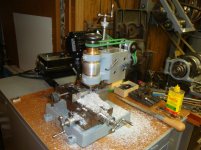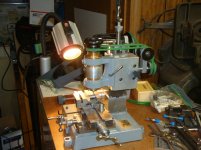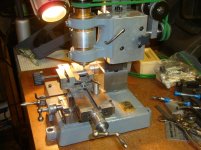georgesbasement
Aluminum
- Joined
- Dec 9, 2004
- Location
- southeast Pennsylvania
Many years ago I acquired a Derbyshire Micromill, for which I've been seeking a practical use.
Now I've hit upon one: Hobbing small gears such as the 48DP change gears used for instrument lathe threading attachments.
After much thought, I worked out a conservative method of dealing with the helix angle of the hob (which I already have !). I'll detach the column from the base, and add a pair of plates, one bolted to the base, the other fastened to the column, with the means to swivel about a vertical axis. I'll set the angle with a sine bar, and that will remain the same for all gears made with that hob.
The gear blank has to rotate by one tooth for each rotation of the hob. I'll use the "unattainable" 127-tooth gear as the ultimate example, as so many will go to any lengths to avoid getting or making one. There already has to be a right angle between the axes of the cutter and gear blank (ignoring the hob's helix angle for the purpose of this part of the discussion), and a worm gear fits this bill very nicely, as well as increasing the accuracy of the tooth spacings.
It appears that a 40-tooth worm gear and one-start worm will do for rotating the gear blank ... but only if the worm is rotated 40/127th of a revolution for each rotation of the hob. That demands a 40-tooth gear on the hob's spindle and a 127-tooth gear on the worm. I'll mount the 40-tooth gear right on the hob arbor (which will be an extended "blank" 8mm collet) and the 127-tooth gear on a carrier bolted in place of the spindle-elevating rack, which won't be needed once the hob's centerline has been set for the gear blank. A double-U-jointed drive shaft will connect the 127-tooth change gear to the worm on the blank's carrier. That will allow me to machine a gang of gear blanks all at once without affecting the gear-to-gear meshing.
This arrangement requires no changes to the table movements, which in the case of my Micromill consist of a screw-fed Y axis and a lever & cam fed X axis.
All of these changes are reversible.
I've done something like this with a Brown & Sharpe indexing head and even on an Atlas indexing head:
http://www.georgesbasement.com/ToolP...eIndexCenters/
http://www.georgesbasement.com/ToolP...dexingCenters/
At the bottom of my Atlas page there is a section on making 127 divisions without using a 127-tooth master. This Micromill project carries the concept one step farther.
Any and all comments are entirely welcome !
Best regards,
George
George Langford in SE PA
george (at) georgesbasement(dot) com
georgesbasement on Practical Machinist
Now I've hit upon one: Hobbing small gears such as the 48DP change gears used for instrument lathe threading attachments.
After much thought, I worked out a conservative method of dealing with the helix angle of the hob (which I already have !). I'll detach the column from the base, and add a pair of plates, one bolted to the base, the other fastened to the column, with the means to swivel about a vertical axis. I'll set the angle with a sine bar, and that will remain the same for all gears made with that hob.
The gear blank has to rotate by one tooth for each rotation of the hob. I'll use the "unattainable" 127-tooth gear as the ultimate example, as so many will go to any lengths to avoid getting or making one. There already has to be a right angle between the axes of the cutter and gear blank (ignoring the hob's helix angle for the purpose of this part of the discussion), and a worm gear fits this bill very nicely, as well as increasing the accuracy of the tooth spacings.
It appears that a 40-tooth worm gear and one-start worm will do for rotating the gear blank ... but only if the worm is rotated 40/127th of a revolution for each rotation of the hob. That demands a 40-tooth gear on the hob's spindle and a 127-tooth gear on the worm. I'll mount the 40-tooth gear right on the hob arbor (which will be an extended "blank" 8mm collet) and the 127-tooth gear on a carrier bolted in place of the spindle-elevating rack, which won't be needed once the hob's centerline has been set for the gear blank. A double-U-jointed drive shaft will connect the 127-tooth change gear to the worm on the blank's carrier. That will allow me to machine a gang of gear blanks all at once without affecting the gear-to-gear meshing.
This arrangement requires no changes to the table movements, which in the case of my Micromill consist of a screw-fed Y axis and a lever & cam fed X axis.
All of these changes are reversible.
I've done something like this with a Brown & Sharpe indexing head and even on an Atlas indexing head:
http://www.georgesbasement.com/ToolP...eIndexCenters/
http://www.georgesbasement.com/ToolP...dexingCenters/
At the bottom of my Atlas page there is a section on making 127 divisions without using a 127-tooth master. This Micromill project carries the concept one step farther.
Any and all comments are entirely welcome !
Best regards,
George
George Langford in SE PA
george (at) georgesbasement(dot) com
georgesbasement on Practical Machinist








